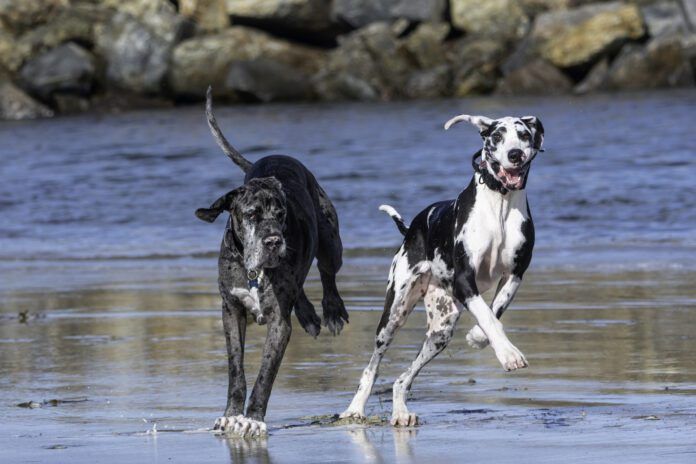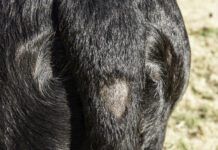Discospondylitis in dogs occurs when a bacterial or fungal infection travels to the spine. The infection might just be at one point in the spine or could be at multiple spots at once. Note: Discospondylitis is different from spondylosis in dogs. While discospondylitis is an infection, spondylosis is a degenerative disorder of the bones in the spine.
How Discospondylitis Happens
Usually, the bacteria or fungi access the dog’s spinal discs via the bloodstream. An infection starts somewhere else in the body, such as in the mouth, on the skin, or in the urinary tract, and then the infectious agents hitch a ride in the blood. As blood circulates through the body, the bacteria or fungi may stop in the spinal discs and start up a new infection there.
Another cause of discospondylitis is a migrating foreign body, such as a grass awn or foxtail. These barbed awns can enter the body a variety of ways and then slowly move through tissue. The trail left behind is the perfect opportunity for infectious pathogens to follow along.
The third way that a dog can develop discospondylitis is after trauma to the back, such as a bite wound, getting hit by a car, or in rare cases secondary to back surgery.
Who’s at Risk?
Any dog can get discospondylitis, but large and giant breeds are the most often affected. Examples include the Great Dane, German Shepherd Dog, Boxer, Rottweiler, Doberman, and English Bulldog.
Chronic skin infections, having an immune system disorder, or being on immunosuppressive medications may predispose a dog to spinal infection.
What Discospondylitis in Dogs Looks Like
The symptoms of discospondylitis are non-specific, which means they can look like a variety of injuries and illnesses. Possible symptoms include:
- Pain
- Stiffness
- Reluctance to move
- Avoidance of jumping and/or stairs
- Flinching when touched
- Fever
- Poor appetite
- Weight loss
- Lethargy
If the infection has caused the disc to swell and put pressure on the spinal cord, the dog may also have neurological deficits such as stumbling or dragging one or more paws. Over time this can progress to limb weakness, muscle loss, and even paralysis.
Exact symptoms can also vary depending on the location of the infection site(s). Discospondylitis most commonly occurs in the thoracic and lumbar spine regions along the dog’s back.
Getting a Diagnosis
Diagnosing discospondylitis in dogs can take a while. The same symptoms can result from a variety of conditions, which means your vet needs to parse through all the potential causes.
X-rays are the simplest way to make a diagnosis. The catch is that it takes three to six weeks after symptoms start for bony changes to be visible on an X-ray. It may take a couple rounds of X-rays to see evidence of discospondylitis.
Advanced imaging such as myelography, CT scan, MRI, or bone scintigraphy can pick up signs of discospondylitis sooner. These procedures usually require a trip to a specialist.
Once discospondylitis is on your veterinarian’s radar, the next step is to identify the bacteria or fungus causing the infection. Your veterinarian may take blood and urine samples to culture, and will test for brucellosis. In some cases, a spinal tap to take a sample of cerebral spinal fluid may be necessary. This can be done under anesthesia by a specialist.
Rarely, the infected disc itself may be cultured. This requires surgery done by a specialist and is usually avoided because of how invasive it is.
Treatment
Treatment for discospondylitis often takes six to 12 months to clear the infection. Your dog will receive an antibiotic or antifungal medication depending on the type of infection, with the exact medication determined by the culture and sensitivity testing. Fungal infections are generally more difficult to eradicate than bacteria.
Your dog may also receive pain meds to keep him comfortable.
In some cases, it may be necessary to do surgery to debride damaged tissue, flush out the area, and relieve pressure on the spinal cord. This procedure should be done by a board-certified specialist.
Most dogs show improvement within two weeks of starting treatment. If your dog does not improve at that time, your vet will reassess and determine a new plan. Serial X-rays can be helpful to track healing of the bones in the spine over time.
Bacterial discospondylitis has the best prognosis. These dogs may relapse during the treatment period, but usually the infection can be fully treated.
Fungal discospondylitis has a more guarded prognosis. Many dogs respond to treatment, but others do not. Some dogs require lifelong medication to control symptoms and keep them comfortable.
Discospondylitis due to the bacterial infection brucellosis cannot be cured. This disease requires lifelong medication and careful management because it can be passed to humans and other dogs.
For all types of infection, severe neurological symptoms indicate a worse prognosis.
If your dog is diagnosed with discospondylitis, it is important to be diligent with medications for the full treatment period. Six to 12 months is a long time to give meds, but if it can get your dog back to his normal life, it is worth it!





